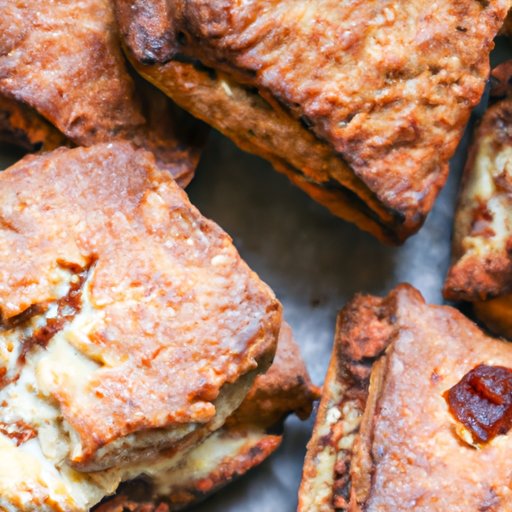
I. Introduction
Do you love scones but find the thought of making them at home intimidating? Making scones can seem like a daunting task, but with the right know-how, it’s actually one of the easiest things to make. In this article, we’ll provide a step-by-step guide for making perfect scones every time, along with variations, tips, and tricks for creating your own unique recipe. So, put on your baking hat and let’s get started!
II. Step-by-Step Guide for Making Scones
To start with, you need to gather the ingredients and equipment. Making scones requires basic kitchen tools, such as a mixing bowl, pastry cutter or food processor, and a baking sheet lined with parchment paper. As for ingredients, you’ll need flour, sugar, baking powder, butter, salt, milk, and an egg. Once you have everything, it’s time to get your hands dirty.
First, preheat your oven to 400 degrees F. Mix together the dry ingredients in a bowl – 2 cups of flour, 1/4 cup of sugar, 4 teaspoons of baking powder, and 1/4 teaspoon of salt. Add in 1/3 cup of butter and use a pastry cutter or food processor to blend all the ingredients together. Your mixture should look like coarse crumbs.
Blend an egg and 2/3 cup of milk in a separate bowl and then add to the dry mixture, stirring until just combined. Be careful not to overmix as this can cause the scones to become tough. Roll the dough into a disk shape, and cut it into wedges before placing it on the baking sheet.
Bake in the oven for approximately 15 minutes or until the scones have a golden brown color. Remove from the oven and serve warm with your favorite toppings.
III. Variations of Classic Scone Recipe
The beauty of scones is that they can be altered to suit any taste preference. Want to experiment with different flavors? Try adding bacon and cheese for a savory treat or dried fruit and nuts for a sweeter scone. Want to mix up your add-ins? Add chocolate chips, berries, or even lemon zest for a tangier twist.
If you’re new to baking, it’s best to start with just one or two add-ins to prevent the dough from becoming too saturated. Remember to also adjust your liquid measurements accordingly if you’re adding more dry ingredients to avoid a crumbly texture.
IV. Using Videos for Better Instructions
Everyone learns differently, and sometimes it’s easier to follow along with a video rather than just written instructions. Check out this helpful video tutorial for a visual, step-by-step guide to making scones.
V. Tips and Tricks for Perfect Scones
To make sure your scones come out light, flaky, and delicious every time, follow these expert tips:
- Use cold butter and milk to prevent the dough from becoming too warm.
- Gently fold the wet and dry ingredients together until just combined.
- Knead the dough as little as possible to prevent air from escaping.
- Use a sharp knife to cut the scones into wedges.
- Bake the scones on the middle rack of the oven for even cooking.
And, here are some common mistakes to avoid:
- Overmixing the dough, which can result in tough scones.
- Using a warm oven, which can cause the butter to melt and change the texture of the scones.
- Not using enough flour when rolling out the dough, which can make it stick to the surface.
VI. History of Scones
Scones originated in Scotland and were originally made with oats, shaped into a large round that was divided into triangles for serving. They were then served with clotted cream and jam, and this tradition has continued to this day. From Scotland, it spread to England and eventually to other parts of the world. Today, scones are a beloved pastry that has evolved into different variations depending on where you are in the world.
VII. Gluten-Free and Vegan Options
Good news for those with gluten intolerances or vegan dietary restrictions – there are alternative ingredients that can be used in scones to accommodate your dietary needs. Instead of regular flour, opt for gluten-free flour or almond flour, and use vegan butter or coconut oil instead of dairy butter. Oat milk, almond milk also works instead of cow’s milk.
VIII. Recipe Ideas for Leftover Scones
So, what can you do with leftover scones? Here are three ideas to get you started:
- Make scone French toast by cutting the leftover scones in half and dipping them in a mixture of eggs, milk, and cinnamon before frying them up like regular French toast.
- Create a scone crumble by breaking up the leftover scones into small pieces and mixing them with nuts, oats, and sugar. Spread the mixture on a baking sheet and bake for 15 minutes or until golden brown.
- Use your leftover scones to make a strawberry shortcake. Simply cut the scones in half, spread some whipped cream or ice cream of your choice and garnish with your favorite fruits and chocolates.
IX. Conclusion
Making scones at home doesn’t need to be intimidating. With a few ingredients and some simple steps, you can create a delicious pastry that is perfect for any occasion. We hope this article has provided you with all the information you need to make scones on your own, along with some variations to experiment with. Give it a try and enjoy the satisfaction of baking your own perfect batch of scones!
Don’t forget to share your creations with us, and leave any questions or feedback in the comments below.




